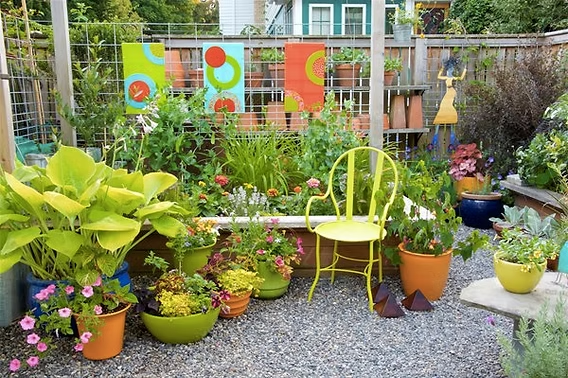
If you’ve been staring at a patch of dirt in your backyard wondering what on earth to do with it—trust me, I’ve been there too. Bare ground not only looks messy, but it also turns muddy when it rains, gets dusty when it’s dry, and generally makes the entire yard feel unfinished. Whether you’re dealing with a neglected corner, a whole backyard makeover, or just want to cover up a worn-out patch, there are some seriously creative solutions that can work for every budget.
In this post, I’m sharing 12 ideas I’ve either tried myself or bookmarked for future yard projects. These are practical, stylish, and most importantly—doable. Some take a weekend of work, while others can be done in just a couple of hours. Let’s explore how we can say goodbye to the dirt and hello to a backyard you’ll actually want to spend time in!
1. Lay Down Mulch

Mulch is one of my favorite go-to solutions for covering dirt quickly and cheaply. It instantly gives the space a more landscaped, intentional look, and there are so many types to choose from—bark, wood chips, rubber mulch, or even composted leaves. The best part? You can just dump it over your dirt and rake it into place. No fancy equipment needed.
When I used mulch in my side yard, I laid down landscaping fabric first to keep the weeds from popping through. That combo has held up really well even through rainy seasons. Plus, mulch helps retain moisture in the soil if you’re planning to plant shrubs or flowers nearby.
This is also a great option if you’re not quite ready to commit to hardscaping or turf. It gives you a clean slate that you can build on later—and if you change your mind, it’s easy to remove or compost. Just be mindful of choosing mulch that’s safe for pets and kids if they’ll be playing nearby.
2. Install Artificial Turf

I know artificial grass sometimes gets a bad rap, but hear me out—it has come a long way! I installed turf in a corner of my backyard that got absolutely no sunlight, and it was a game changer. No mowing, no watering, no mud. Just bright, green, low-maintenance space.
The key to making artificial turf look good (and last) is the prep. I had to dig out a few inches of dirt, level the area, and add a base layer of crushed rock before laying down the turf. It’s definitely a bit of work up front, but totally worth it once it’s done. Now my dog has a clean place to run, and it always looks neat—even after heavy rain.
I especially love how it works in tricky spots where real grass just won’t grow. You can even mix turf with pavers or gravel for a more designer look. It’s one of those upgrades that makes a dirt patch feel like part of a thoughtfully designed yard.
3. Use Gravel or Crushed Stone

Gravel is such a versatile and stylish way to cover up backyard dirt. I’ve used it to create walkways, seating areas, and even a little Zen corner for potted plants. It adds great texture, comes in tons of colors and sizes, and holds up really well over time.
One thing I love about gravel is how low-maintenance it is. Once it’s down and compacted, it doesn’t shift too much, especially if you edge the space with stone or timber. Just like with turf or mulch, laying landscaping fabric underneath helps keep weeds at bay, which is a lifesaver down the road.
Whether you’re into modern minimalist designs or more rustic garden vibes, there’s a gravel style to match. Try mixing pea gravel with larger flagstones or stepping stones for a more custom look. And if you’re covering a large area, crushed granite is another great choice—it compacts tightly and looks super polished.
4. Plant Ground Cover Plants

If you love a natural, lush look, ground cover plants are the way to go. I’ve slowly started replacing the dirt patches under my trees with creeping thyme and clover, and wow—it makes such a difference. They spread quickly, choke out weeds, and bring color and softness to the space.
Depending on your climate and sun exposure, there are so many great options to try. Moss is gorgeous in shady areas, while sedum and creeping Jenny thrive in full sun. Ground covers not only look beautiful, but they also help reduce erosion and improve soil health over time. It’s kind of like giving your yard a living carpet.
What I love most is that once these plants are established, they take care of themselves with minimal effort. Just water them during dry spells and trim back any overgrowth. If you’re patient and want a green fix that keeps giving back, this is a long-term win.
5. Add Pavers or Stepping Stones

Stepping stones are such a fun and functional way to cover dirt—and you can really let your creativity shine here. I made a stepping-stone path from my back door to the garden using irregular flagstones and pea gravel in between, and now it’s one of my favorite parts of the yard.
There are so many styles to choose from: square concrete slabs for a modern look, rustic natural stones for a cottage garden feel, or even DIY mosaic pavers if you’re feeling crafty. The key is to plan your spacing and lay them over a firm base so they stay put.
I like to soften the look by adding creeping plants like thyme between the stones or pairing them with mulch or gravel. This type of setup not only hides the dirt, but also defines pathways and breaks up large blank areas in your yard.
6. Install a Raised Deck or Platform

Building a raised deck might sound like a big job, but even a small platform can completely change the feel of your backyard. I once built a simple 6×6 ft deck using pallet wood and placed it over a muddy patch where grass refused to grow. Suddenly, it was the perfect spot for a couple of chairs and a coffee table.
Decks are especially great for covering dirt that’s uneven or prone to puddling. With the right leveling and support, you can raise the surface just enough to create a dry, stable place for relaxing or entertaining. You can even add string lights and planters to dress it up.
If you’re not quite ready for a full-blown deck, try a temporary solution like an interlocking wood tile platform. These are renter-friendly and super easy to install—perfect if you’re on a budget or looking for something quick.
7. Create a Backyard Patio

Turning that dirt area into a patio might just be the backyard upgrade you didn’t know you needed. I laid down concrete pavers in a herringbone pattern for mine, and now it’s the outdoor hangout zone we use the most. You can use bricks, flagstone, concrete, or even reclaimed materials for a more rustic vibe.
Prep is important here. You’ll want to dig out a few inches, level the surface, and lay down gravel or sand before adding your pavers. But once it’s done, you’ve got a durable, mud-free space perfect for furniture, grills, or fire pits.
To make it feel cozy, I layered on some outdoor rugs, string lights, and a couple of oversized planters. It instantly turned that dusty corner into a stylish little patio escape. Plus, it adds real value to your home if you’re thinking about resale.
8. Lay Down Outdoor Rugs or Mats

This might be the quickest fix of all—but don’t underestimate its impact. Outdoor rugs are perfect for temporary cover-ups, especially in rented spaces or when you’re not ready for major landscaping. I’ve used them on bare dirt under a canopy, and they instantly made the area feel pulled together.
Look for rugs made of polypropylene or other weather-resistant materials. They’re durable, washable, and come in so many fun patterns. You can layer them under a dining set or lounge chairs, and suddenly, your yard feels like an outdoor living room.
I always keep a couple on hand for backyard events or impromptu gatherings. And when the season’s over, just roll them up and store them away. It’s an easy win if you need something fast and stylish.
9. Build a Garden Bed or Raised Planters

If you’re into gardening—or even just want to try—it’s a great idea to build raised garden beds over dirt patches. I made two long planter boxes using recycled wood, and filled them with veggies, herbs, and a few flowers. Not only did it hide the dirt, but it gave me a fun weekend project with real results.
Raised beds allow you to control the soil quality, which is a big bonus if your dirt is rocky or poor. They also help with drainage and make weeding and planting easier on your back. Plus, they give structure and a sense of order to the yard, especially when you add edging or gravel paths between them.
You don’t have to go big—even a few medium-sized planter boxes or large pots can work wonders. Get creative with the materials: wood, cinder blocks, metal troughs—whatever fits your style. The bonus? You get homegrown herbs or blooms as part of the transformation!
10. Cover with Bark or Wood Chips Play Area

One of the best uses for a dirt patch—especially if you have kids—is turning it into a natural play area with bark or wood chips. I did this in one corner of my backyard where grass just wouldn’t grow, and it quickly became my kids’ favorite hangout. It’s soft, safe, and gives off a really earthy, playful vibe.
I started by framing the area with pressure-treated timber to create a defined edge, then added a weed barrier underneath before dumping in loads of wood chips. You can find bark mulch in different textures and colors depending on the look you’re going for. I chose a chunky cedar mix because it smells amazing and holds up well in rain.
The great thing about this option is that it’s budget-friendly and easy to refresh every year. Just top it off with a new layer when it starts to look worn. If you don’t have kids, you can still use this idea to create a rustic reading nook, pet play zone, or spot for a hammock and firepit!
11. Use Landscape Fabric + Decorative Pebbles

For a low-maintenance, weed-proof fix, I highly recommend laying down landscaping fabric and topping it with decorative pebbles or stones. I used this method for a narrow strip along my fence that used to collect nothing but weeds and dirt—and now it looks sleek and intentional.
The process is simple: cut the fabric to fit, anchor it down with garden staples, and then pour your choice of stones on top. I went with smooth river pebbles for a polished look, but you can also use lava rocks, white marble chips, or even mixed gravel to match your aesthetic. The combination of textures adds great curb appeal.
This type of ground cover is especially great for spots you don’t walk on much, like along pathways or between raised beds. And unlike mulch or turf, there’s virtually no upkeep aside from the occasional rake or hose-down to keep it clean.
12. Create a Container Garden Oasis

If you’re not ready to commit to permanent landscaping or you love flexibility like I do, a container garden might be your perfect solution. I once covered a large dirt area just by clustering together big pots and planters filled with herbs, flowers, and even a dwarf lemon tree!
The great part is you can move things around whenever you feel like switching it up. I’ve used everything from terracotta pots to galvanized buckets and even painted plastic containers to bring in color and personality. Plus, grouping containers in different heights adds visual interest and totally disguises what’s underneath.
You can also lay gravel, wood chips, or an outdoor rug underneath to tie everything together. This option works well for renters, small spaces, or anyone who loves gardening but needs flexibility. And let’s be honest—there’s something so satisfying about creating your own little jungle from a blank patch of dirt.
Final Thoughts
Backyard dirt doesn’t have to be a permanent eyesore. With the right idea and a little elbow grease, you can turn that dusty patch into something beautiful, useful, and totally you. Whether you go for a lush green fix with turf or plants, or build out a patio or deck, there’s a solution here that fits your budget and your style.
I’d love to know—which idea are you leaning toward? Or maybe you’ve already tried one of these and have tips to share! Drop a comment or send me your backyard before-and-afters—I’d be thrilled to see your transformation.

